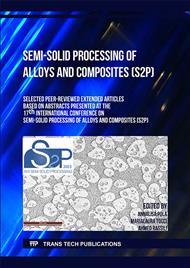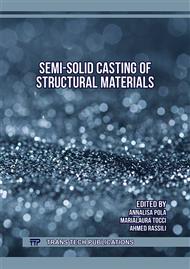p.3
p.11
p.17
p.23
p.31
p.39
p.47
p.53
Comparison of Solidification Microstructure Evolution of Al-10Si and Recycled Aluminium Beverage Can Strips Made in a Strip Caster
Abstract:
A strip caster was used to cast two types of aluminium alloys: an almost eutectic Al-Si alloy (Al 10 Si) with contaminants of 0.6 Fe, 0.2 Pb, and 1.4 Sn, which exhibits a polyphase microstructure upon solidification, and recycled aluminium beverage cans made from Al 0.8 Mn alloy containing 0.4 Si, 0.5 Fe, and 0.1 Mg, which has a monophase microstructure upon solidification. The molten materials were poured at 650 oC (Al 10 Si) and 670 oC (Al 0.8 Mn, 0.4 Si, 0.5 Fe, 0.1 Mg) on a cooling slope specially designed to obtain a semisolid material. This semisolid material was then dragged between rolls at a rate of 0.2 m/s to obtain high-quality metal strips. There was less eutectic modification with larger Al-α grains in the middle region of the sheet between the fine eutectic layers, indicating a lower cooling rate. However, during the recycling of aluminium beverage cans, large grains were formed with a columnar structure at the interface of the rolls, and semisolid melts with cracks were formed between the columnar grain boundaries owing to the compression of the rolls. The middle of these grains contained smaller equiaxial grains that were subjected to dragging. The as-cast specimens were submitted to homogenisation heat treatment at 560 oC for a period of 10 h and cooled to room temperature before being cold rolled (Temper H18) and recrystallised (Temper O) to examine the effect of these treatments on the tensile mechanical properties. During cold rolling (Temper H-18), grain alignment occurred with a yield stress, maximum stress, and elongation of 209.5 MPa, 210.1 MPa, and 2.8%, respectively. The strength decreased (yield stress of 58 MPa and maximum stress of 120.2 MPa) under recrystallisation conditions (Temper O), but the ductility increased (8.9%). This is in contrast to the Al-Si (Al 10Si) strip, which exhibited a yield stress, maximum stress, and elongation of 103.3 MPa, 128.7 MPa, and 1.9%, respectively. The A1 10Si strips also fractured during cold rolling, indicating high material fragility.
Info:
Periodical:
Pages:
23-29
Citation:
Online since:
August 2023
Keywords:
Price:
Сopyright:
© 2023 Trans Tech Publications Ltd. All Rights Reserved
Share:
Citation:



